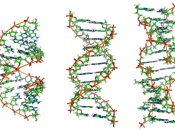Begun formally in 1990, the U.S. Human Genome Project is a 13-year effort coordinated by the U.S. Department of Energy and the National Institutes of Health. The project originally was planned to last 15 years, but rapid technological advances have accelerated the expected completion date to 2003. Project goals are to
*Identify all the approximate 30,000 genes in human DNA,
*Determine the sequences of the 3 billion chemical base pairs that make up human DNA,
*Store this information in databases,
*Improve tools for data analysis,
*Transfer related technologies to the private sector, and
*Address the ethical, legal, and social issues (ELSI) that may arise from the project.
To help achieve these goals, researchers also are studying the genetic makeup of several nonhuman organisms. These include the common human gut bacterium Escherichia coli, the fruit fly, and the laboratory mouse.
A unique aspect of the U.S. Human Genome Project is that it is the first large scientific undertaking to address the ELSI implications that may arise from the project.
Another important feature of the project is the federal government's long-standing dedication to the transfer of technology to the private sector. By licensing technologies to private companies and awarding grants for new research, the project is catalysing the multibillion-dollar U.S. biotechnology industry and promoting the development of new medical applications.
What's a genome? And why is it important?
*A genome is the entire DNA in an organism, including its genes. Genes carry information for making all the proteins required by all organisms. These proteins determine, among other things, how the organism looks, how well its body metabolizes food or fights infection, and sometimes even how it behaves.
*DNA is made up of four similar chemicals (called bases and abbreviated A, T, C, and G) that are repeated millions or billions of times...


